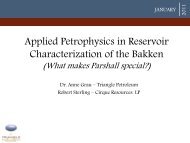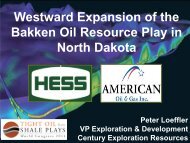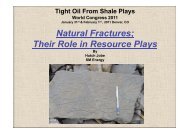Scott Oelfke, Geographix - Tight Oil From Shale Plays World ...
Scott Oelfke, Geographix - Tight Oil From Shale Plays World ...
Scott Oelfke, Geographix - Tight Oil From Shale Plays World ...
- No tags were found...
Create successful ePaper yourself
Turn your PDF publications into a flip-book with our unique Google optimized e-Paper software.
Unconventional Field Planning Using GISand Linear Programming<strong>Scott</strong> <strong>Oelfke</strong>Product Manager - Data and Mapping1.31.2011
Unconventional Resource <strong>Plays</strong>© 2010 LMKR. All Rights Reserved. 2
Resource <strong>Plays</strong> - What’s Really Changed?Where are all the dry holes?Factory production techniquesRapid pace of drilling© 2010 LMKR. All Rights Reserved. 3
Where’s the risk?Risk is migrating away from exploration. Uneconomic wells havebecome the biggest risk factor affecting Net Present Value.Containing costs is becoming critical© 2010 LMKR. All Rights Reserved. 4
How can risk be managed?Generate multiple field development scenariosDetermine NPV implications due to changes within a givenscenarioPerform risk-based Net Present Value analysis that accounts for• Production risk• Political risk© 2010 LMKR. All Rights Reserved. 5
What does this have to do with GIS?Our industry is map-centric. Almost every asset has a locationand can be displayed on a mapPad templatesPads collect hydrocarbons over a defined area. So treat each pad“drainage template” as a financial unit for field planning• Integrate of field planning and financial analysis• Produce multiple field planning scenarios• Utilize geoprocessing tools to incorporate risk-based NPVcalculations© 2010 LMKR. All Rights Reserved. 6
Why Use Pads to Calculate NPV? Why not use wells?• Geoprocessing works especially well with polygonso Tools to avoid pad hazardso Tools to assess production risk“it’s cheaper to drill more wells on fewer pads, but how muchcheaper?”© 2010 LMKR. All Rights Reserved. 7
What is Geoprocessing?A process that converts an input dataset (vector or raster) into anew dataset with a different set of propertiesClip, projection, weighted overlay, fuzzy logic, intersect,proximity© 2010 LMKR. All Rights Reserved. 8
GeoprocessingSlope analysis© 2010 LMKR. All Rights Reserved. 9
GeoprocessingLand Use© 2010 LMKR. All Rights Reserved. 10
Pad HazardsPad Hazardsy’yx’x© 2010 LMKR. All Rights Reserved. 11
Geoprocessing for Hazards AnalysisWATERSLOPEUNIONHAZARDSCLIPSHAPEFILERASTERIZEANDROTATERASTERHAZARDSHABITATFIELDAREAThe fundamental purpose of geoprocessing is to provide toolsfor performing analysis and managing geographic data.© 2010 LMKR. All Rights Reserved. 12
Production Risky’yProbability of ExceedingExpected EUR90%85%80%70%x’50%x© 2010 LMKR. All Rights Reserved. 13
Risk AnalysisWeighted OverlayTOC + Seismic Attribute = Probability© 2010 LMKR. All Rights Reserved. 14
Geoprocessing for Risk AnalysisTOCRASTERRECLASSIFYWeightedOverlayRISKPROBABILITIESTableAnalysisPADTEMPLATESeismicAAributesRASTERRECLASSIFYPADTEMPLATESThe fundamental purpose of geoprocessing is to provide toolsfor performing analysis and managing geographic data.© 2010 LMKR. All Rights Reserved. 15
Field Planning using 2D Linear ProgrammingPad templatesy’yx’x© 2010 LMKR. All Rights Reserved. 16
Optimized Field PlanningPad templatesy’yPad HazardsPad Locationsx’x© 2010 LMKR. All Rights Reserved. 17
2D Linear Programming2D Linear cutting stock algorithms (bin packing)• Mainly used in the furniture, garment and glass industries for generatingoptimized cutting layouts and reducing waste generated by 2 DimensionalRectangular cutting• Algorithm must be modified to account for pad hazards and rig schedulingand availability• Horizontal wells are often oriented perpendicular to the minimum principalstress direction. In order to solve these problems using linear programming,the solution space must be transformed into a local x/y coord system that iscoincident with the principal stress directions© 2010 LMKR. All Rights Reserved. 18
Proximity ToolPad HazardsUse the Proximity geoprocessing tool to auto-calculate new padlocations• May have negative effect on NPV due to higher costs© 2010 LMKR. All Rights Reserved. 19
Quantify Production RiskPad templates847070Probability of ExceedingExpected EUR74 83 707870%81847265%6860%50%40%© 2010 LMKR. All Rights Reserved. 20
Use Microsoft Excel for NPV Calculations© 2010 LMKR. All Rights Reserved. 21
Field Planning (the virtuous triangle)Plan Pad LocationsFactor in RiskCalculate NPV90%85%80%70%Recalculate field NPV as pad locations or drilling andmaintenance costs are updated© 2010 LMKR. All Rights Reserved. 22
ConclusionsUtilizing GIS geoprocessing tools for field planning aids in padplacement and may result in better evaluation of productionrisks.Associating costs and projected cash flows with a pad“template” instead of individual wells is an alternate and perhapsbetter way to calculate Net Present Value in some cases© 2010 LMKR. All Rights Reserved. 23
ReferencesA Probabilistic Approach to <strong>Shale</strong> Gas Economics• William M. Gray, SPE, Troy A. Hoefer, SPE, and Andrea Chiappe, SPE, Pioneer NaturalResources USA, Inc.; and Victor H. Koosh, SPE, Caesar Petroleum Systems, LLC• 2007 SPE Hydrocarbon Economics and Evaluation Symposium, Dallas, TexasField planning and development of <strong>Oil</strong> and Gas Reservoirs usingGIS Technology• John E. Pierce II and Richard T. Hill; J P Kenny Inc• GIS for <strong>Oil</strong> and Gas Proceedings, 2000© 2010 LMKR. All Rights Reserved. 24







